Laparoscopic resection of primary retroperitoneal schwannoma:A case report
2020-04-08MarceloAFRibeiroJrYasminGBEliasSamaradeAugustoPaoladerssiaTKCostaAndressaMaurcioAdrianoSampaioAlexandreFonseca
Marcelo AF Ribeiro Jr,Yasmin GB Elias,Samara de S Augusto,Paola R Néder,Cássia TK Costa,Andressa D Maurício,Adriano P Sampaio,Alexandre Z Fonseca
Marcelo AF Ribeiro Jr,General Surgery and Trauma Department,Catholic University of São Paulo - PUC-Sorocaba and Moriah Hospital,São Paulo 04083-002,São Paulo CEP,Brazil
Yasmin GB Elias,Samara de S Augusto,Paola R Néder,Cássia TK Costa,Andressa D Maurício,Department of Surgery,Medical School,Santo Amaro University,São Paulo 04743-030,São Paulo State,Brazil
Adriano P Sampaio,Alexandre Z Fonseca,General Surgery and Trauma Department,Moriah Hospital,São Paulo 04083-002,São Paulo State,Brazil
Abstract BACKGROUND Schwannomas are rare,often benign,tumors deriving from Schwann cells that have low incidence in the retroperitoneal region(0.5% to 5%).Their diagnosis is hardly confirmed at early stage due to lack of specific features in signs,symptoms and imaging tests.Thus,it is necessary performing guided punch biopsy in order to identify it.Tumor removal is the treatment of choice due to its low sensitivity to radiation and chemotherapy.CASE SUMMARY Forty-seven years old female patient who was hospitalized for elective orthopedic procedure,without complications,evolved with severe pain in the lower limbs,thigh and gluteal region associated with neurogenic claudication.Persistent pain required magnetic resonance imaging(MRI)of the lumbar spine,which showed epidural collection with dural compression and massive heterogeneous perihepatic nodular lesion.The surgical team opted for draining the collection,as well as requested an MRI of the abdomen and pelvis,whose analysis showed expansive lesion in the retroperitoneum,in close contact with the inferior vena cava and with the right renal vein.A guided puncture was performed for diagnostic clarification,which showed immunohistochemical profile compatible with schwannoma.The selected treatment comprised retroperitoneum tumor resection in association with laparoscopic cholecystectomy.The patient was discharged and remained stable after 4-mo follow-up;she remains under followup to check the need of cancer investigations.CONCLUSION Schwannoma features requires surgical treatment based on laparoscopic resection,which often presents low relapse rates and optimistic prognosis.
Key Words:Neurilemmoma;Neoplasms;Retroperitoneal space;Laparoscopy;Case report
INTRODUCTION
Schwannomas are rare tumors deriving from Schwann cells found in peripheral nerve sheaths[1-8];they are often diagnosed in patients’ head,neck and extremities[1-10].Schwannoma incidence in the retroperitoneal region is quite rare;it accounts for only 0.5% to 5% of all cases of it[7].Such incidence prevails among women,mainly in patients in the age group 20-60 years,although it can affect individuals at any other age[1-10].
Early schwannoma diagnosis is unusual due to lack of specific signs and symptoms capable of characterizing the disease and of leading patients to seek medical help[1-5,7,9-11].In addition,findings of ultrasound images,computed tomography(CT)and magnetic resonance imaging(MRI)directly linked to the disease are poorly described.Thus,many cases are diagnosed incidentally during imaging exams.Advanced stage schwannomas can be associated with abdominal pain or palpable abdominal tumor,and even with atypical symptoms such as secondary hypertension,hematuria,renal colic and headache[1-7,9,11].Schwannomas are often benign;however,they can lead to malignant tumor transformation when they are associated with Von Recklinghausen’s disease[1,2,4,6,7].It is necessary performing CT- or ultrasound-guided punch biopsy,with anatomopathological report,in order to confirm the preoperative diagnosis and start treatment[1,2,6,7,11].Surgical removal of the tumor is the treatment of choice,since schwannomas are not very sensitive to radiotherapy and/or chemotherapy[1-11].
The aims of the current study were to report the case of a primary retroperitoneal schwannoma incidentally diagnosed and to present a literature review on the topic.
Description of a retroperitoneal schwannoma case treated based on laparoscopic approach without complications,and review of similar cases described in the literature for the last 20 years.
CASE PRESENTATION
Chief complaints
A 47-year-old female patient was admitted to the orthopedics service to undergo elective decompression surgery and lumbosacral spine arthrodesis(L4,L5,S1).
History of present illness
The orthopedic procedure was performed without complications.On the first postoperative day,the patient presented severe pain in the anterior aspect of the thigh,bilateral burning in the gluteal region and lower limbs in shock with neurogenic claudication.
History of past illness
Patient’s comorbidities comprised type II Diabetes Mellitus and hypothyroidism.The patient used 500 mg Metformin twice a day and 50 μg Levothyroxine once a day,on a regular and continuous basis,and did not have allergies.
Physical examination
The patient was in good general condition;she was flushed,hydrated,eupneic,afebrile and presented obesity grade I.The physical examination of the chest and cardiovascular system did not present relevant findings.Patients’ abdomen was flaccid and painless;it presented normal noises and did not show visceromegaly or palpable masses.Her orthopedic surgical incision presented satisfactory appearance.She had been submitted to a specific spinal cord MRI prior to her orthopedic surgery.
Imaging examinations
Lumbar CT was requested an d,since the patient presented persistent pain on the 5thpostoperative day,MRI of the lumbar spine was also requested;results showed posterior epidural collection in L3 and L4 with dural and spinal canal compression,as well as massive heterogeneous nodular perihepatic lesion(of undetermined nature)anterior to the right kidney.There were no association between the collection and the Schwannoma.The patient was subjected to a new surgery to drain the 50 mL collection that caused dural sac compression;the procedure did not show complications.
Given the heterogeneous mass found in front of the right kidney,which led to significant thinning of the inferior vena cava in lesion topography,the general surgery team was required to assess the patient,who had her pain stabilized and did not have new episodes of it.MRI of the abdomen and pelvis was requested by the general surgery team;results have shown undetermined,expansive,7.2-cm retroperitoneal lesion on the right side of patient’s body - it was in close contact with the inferior vena cava and with the right renal vein,which caused a compression that extended toward the left renal vein(Figure 1 and 2).The patient did not present compressive symptoms associated with the lesion.
Anatomopathological examination
CT-guided puncture was performed to collect two biopsy fragments,which were subjected to anatomopathological analysis for diagnostic clarification purposes.Analysis results have shown fusiform neoplasia,with discrete nuclear atypia,interspersing more and lesser cellular areas.Mitosis and necrosis figures were not detected.The material was subjected to immunohistochemical profile analysis,which indicated its compatibility to schwannoma.
FINAL DIAGNOSIS
Primary retroperitoneal schwannoma was the final diagnosis of the herein reported case.
TREATMENT
After the case was discussed with the tumor board and the patient,the surgical team opted for resecting the retroperitoneal tumor in association with cholecystectomy(the gallbladder was used to mobilize the liver)vialaparoscopic approach.Port placement is shown in Figure 3.A large lesion was found in the retroperitoneum(zone II)during the procedure;it was adhered to patient’s duodenum,vesicle,kidney,right renal vein and inferior vena cava(Figure 4).An adequate cleavage plan for safe lesion resection was identified;although labor-intensive,the surgery was carried out safely and did not have intraoperative complications(Figure 5).The surgical specimen had nodular aspect and was covered by a thin brownish membrane(dimensions:8.2 cm × 6.4 cm ×5.3 cm),as shown in Figure 6 and 7.
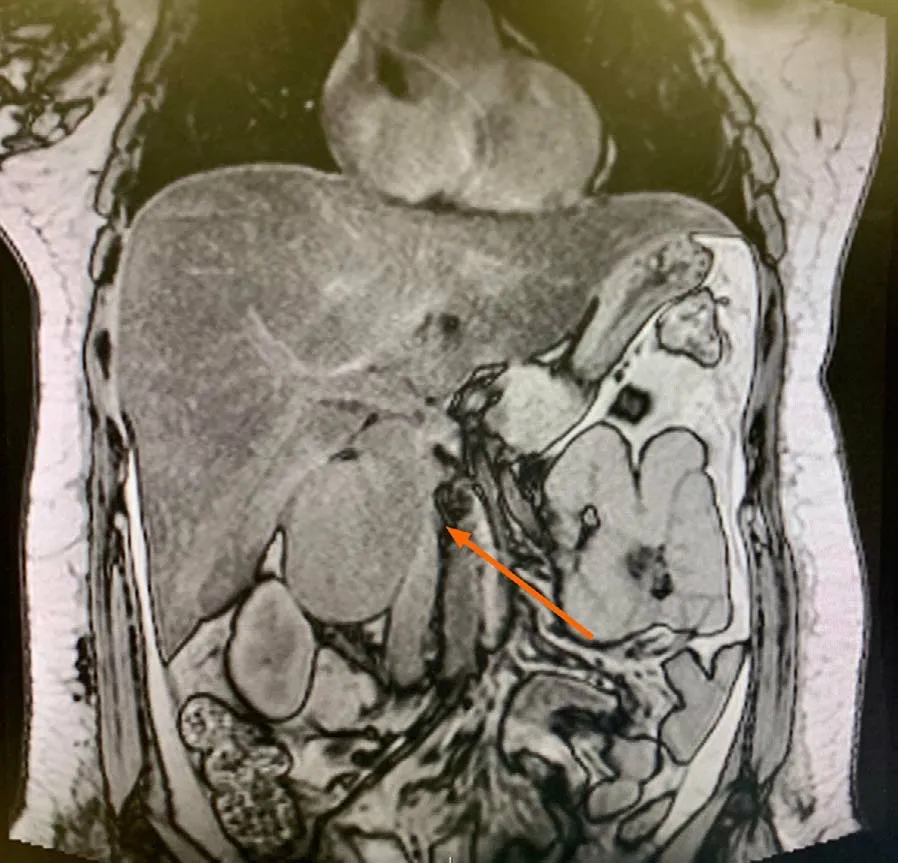
Figure 1 Magnetic resonance imaging of the coronal section showing a large tumor mass compressing the lateral wall of the inferior vena cava.
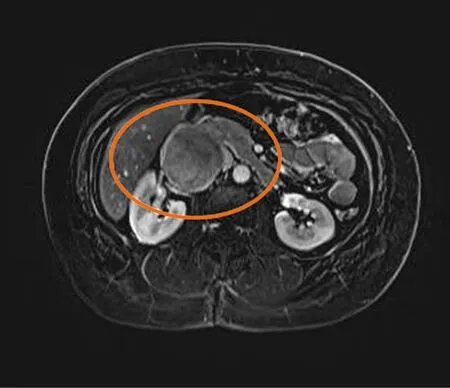
Figure 2 Magnetic resonance imaging of the axial section showing close correlation among lesion,inferior vena cava,right renal vein and duodenum,and small cleavage plane among the structures.
OUTCOME AND FOLLOW-UP
The immunohistochemical analysis applied to the specimen resected during surgery has shown the following results:Positive CD-56;positive CD-68;positive EMA;positive Ki-67 at 7%;strong and diffuse positive S-100.The final anatomopathological report has confirmed that the patient had non-malignant schwannoma;she was discharged on the 3rdpostoperative day.
The patient remained stable,with no complications after 4 mo of the surgery.
DISCUSSION
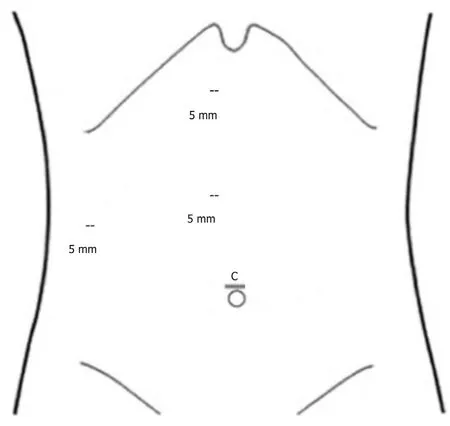
Figure 3 Port placement for laparoscopic approach.
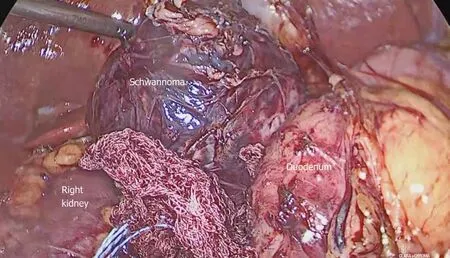
Figure 4 Tumor lesion between the right kidney and the duodenum and above the right renal vein and vena cava.
Schwannomas,which are also known as neurinomas or neurilemmomas,affect women to a greater extent than men[1,2,4,5,7,10].This tumor type accounts for approximately 0.5% to 12% of retroperitoneal tumors[2].Symptoms,whenever present,are nonspecific and delayed due to great retroperitoneum flexibility.The course of the disease is often asymptomatic,and it is incidentally diagnosed at advanced stage[1,2,4,5,7,10]Table 1.The patient in the herein reported case was female and had nonspecific symptoms,such as headache and lower limb pain,which were in compliance with cases described in the literature.It is worth emphasizing that the patient was asymptomatic for retroperitoneal lesion,did not present any type of compressive symptom,neither in the digestive tract nor in the vascular system.Jankowskiet al[9]have reported the case of a patient with history of low back pain and compression on the right side of the sciatic nerve,which led to displacement of the kidney,renal artery and vein,and vena cava,similar to the herein reported case.The aforementioned authors described symptoms such as increased pain at rest,muscle weakness and paresthesia,as seen in the present report before the arthrodesis surgery.Tumor expansion can cause extensive dorsal spine bone destruction,whereas tumor growth can lead to erosive pressure on adjacent bone structures.Schwannomas are often single,with firm and delimited consistency;they often change to form cysts and calcifications,and can present hemorrhages[2,3,5,7,8].The described case was a single,well-defined lesion without local or remote invasive features,which corroboratedpreviously presented data.In histological terms,its featuring was well described as the alternation of Antoni A(elongated and compact spindle cells with paler pattern)and Antoni B(loose cell arrangement in varying medium)areas.The alternation between two areas featured the benign pattern.Malignancy is often determined by the number of mitoses,as well as by vascular invasion and pleomorphism;tumor size is not relevant for such confirmation[1,2,3,5,7]and immunohistochemical analysis shows strong and diffuse S-100 protein mark in the cytoplasm of schwannoma cells[1,2,5,7,11].This pattern is in compliance with the one observed in the analysis of the specimen during surgery.Preoperative imaging exams are of paramount importance to help defining tumor delimitations,although they do not complete the diagnosis in separate.The main manifestations observed in magnetic resonances of retroperitoneal schwannomas are hypointense on T1-weighted sequences and slightly hyperintense on T2-weighted ones;they also show varying enhancement in the presence of intravenous contrast.These patterns found in MRI can change depending on the arrangement of Antoni A and Antoni B areas;malignant schwannomas show intensity confluence in T1- and T2-weighted sequences.Although there are some features at the MRI,it cannot be used as specific standard to diagnose the disease[1-3,5,6,7,10,11].Fibrosarcoma,liposarcoma and ganglioneuroma are differential diagnoses,which present similar pattern in CT and MRI[1,5].Ultrasound- or CT-guided biopsy plays a key role in defining patients’therapeutic plan in the preoperative period.Radio and/or chemotherapy are not recommended due to lack of tumor sensitivity to these treatments[1,2,4,6,7,11].The only approach capable of confirming,and treating,patients’ condition lies on the surgical resection of the identified mass in order to subject it to reliable analysis,as well as to relief patients’ potential symptoms.The laparoscopic and robotic pathways are promising treatment alternatives depending on tumor location and size;they also depend on appropriate training in advanced procedures such as the management of vascular structures and anastomoses[1,2,5-7,8,10,11].The patient in the current case report was subjected to laparoscopic procedure and did not have complications;however,the tumor was in close contact with noble structures such as duodenum,right renal vein and vena cava,which often require meticulous dissection to avoid iatrogenesis.Benign retroperitoneal schwannomas have good prognosis and low relapse rates.Nevertheless,it is necessary monitoring patients after tumor removal because malignant degeneration cases present higher relapse rates[2,7].
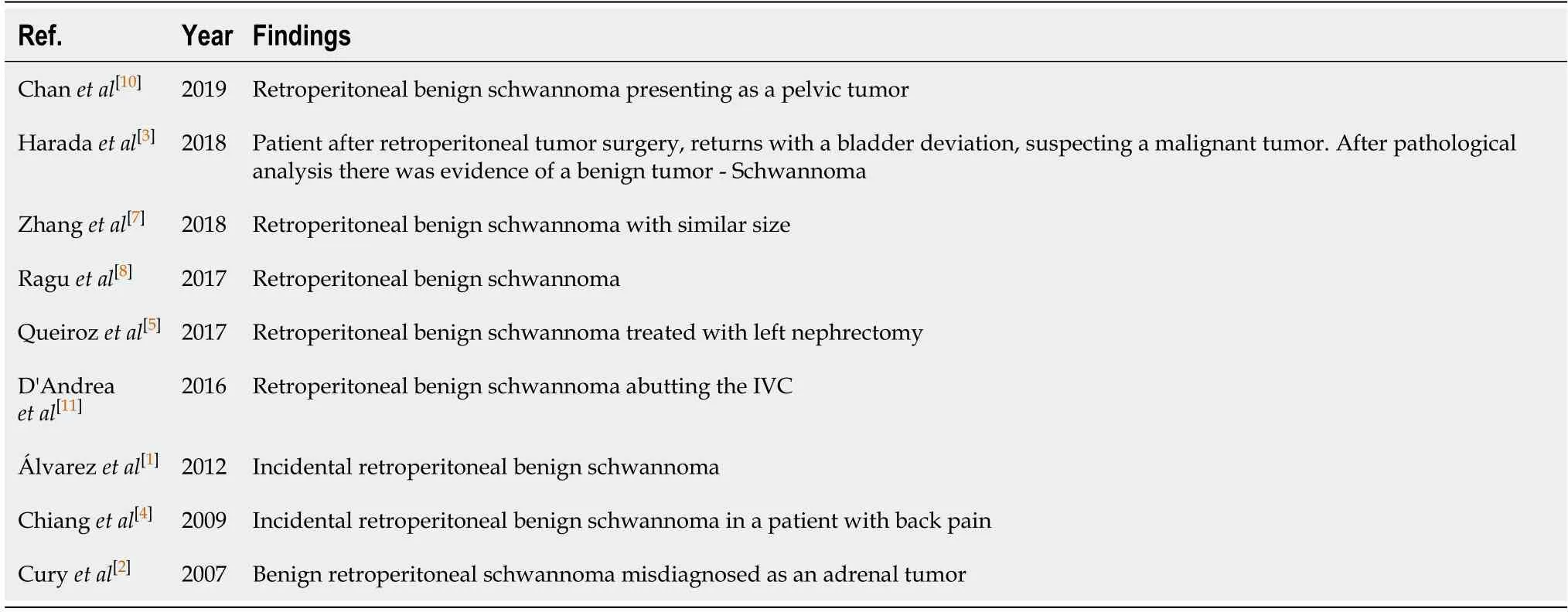
Table 1 Cases reported at the literature related to retroperitoneal schwannomas
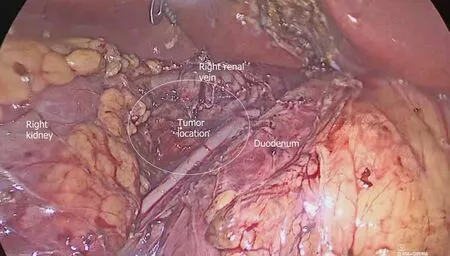
Figure 5 Appearance after resection showing the right kidney,duodenum and the site where the lesion had been found,after specimen removal.
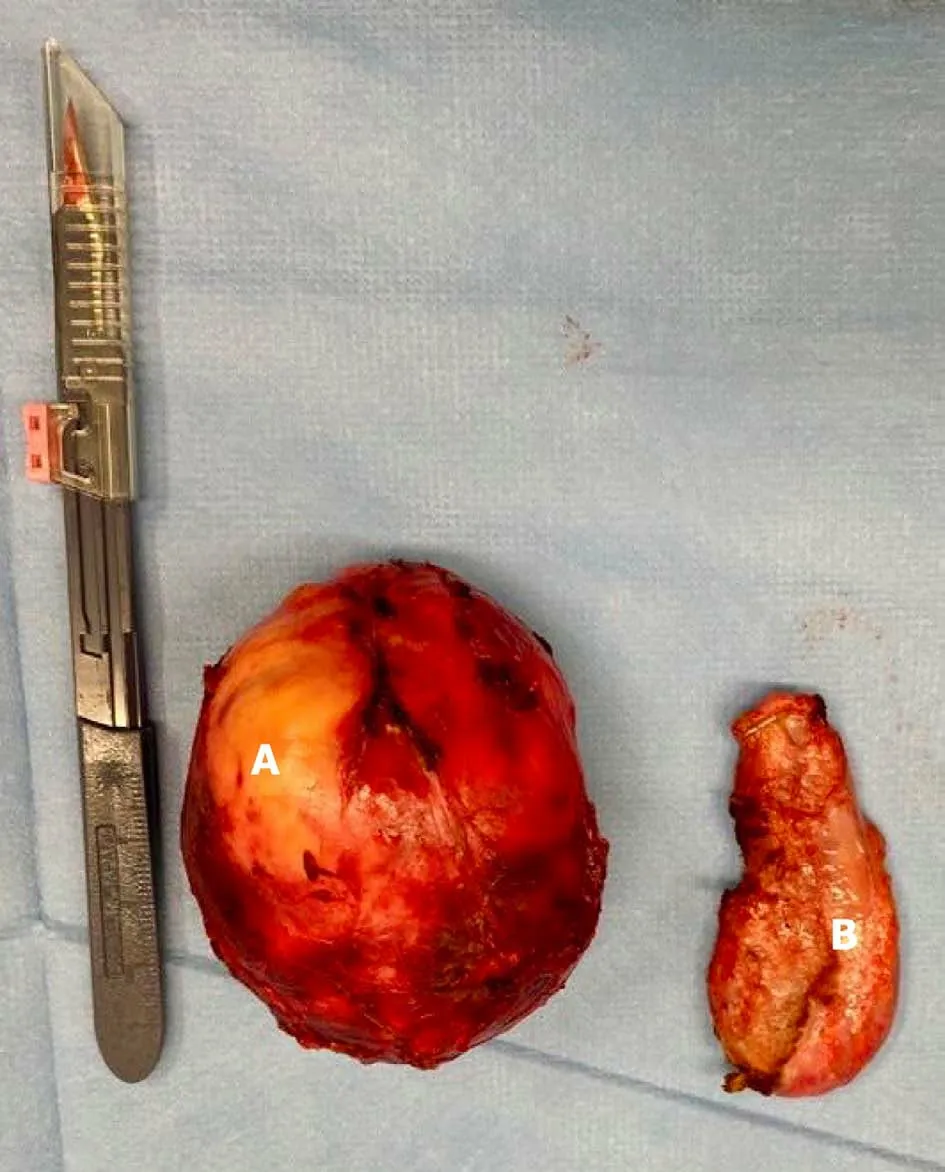
Figure 6 Surgical specimens.A:Schwannoma;B:Gallbladder.
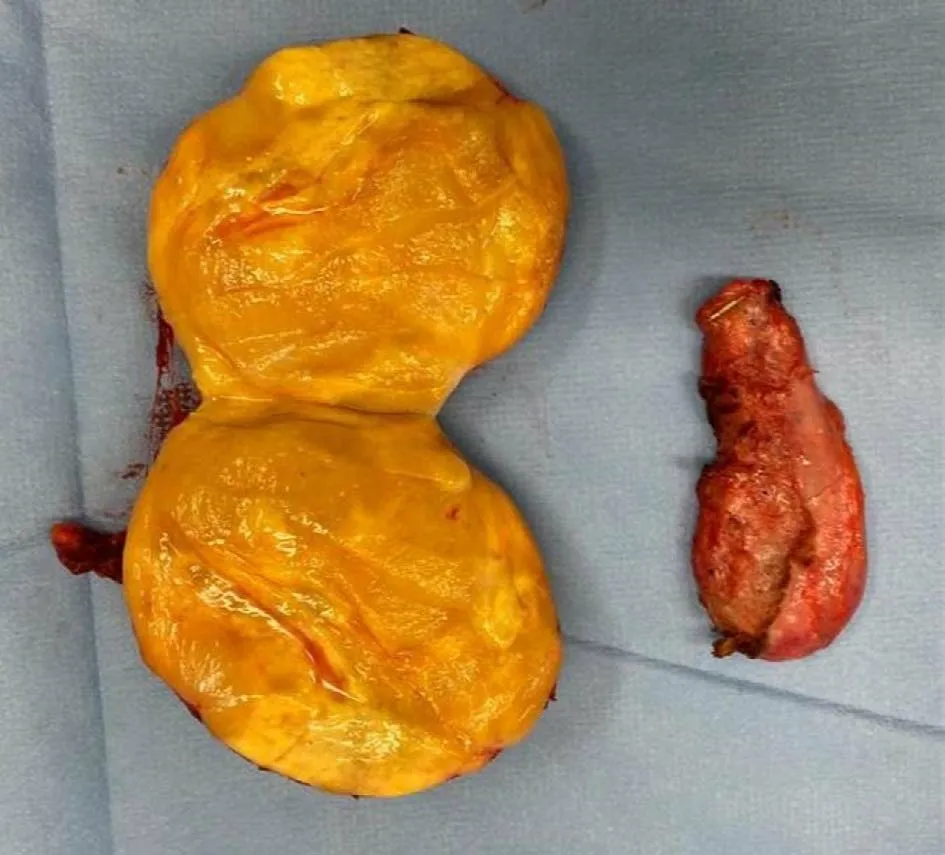
Figure 7 Macroscopic aspect of schwannoma:Encapsulated,well-defined soft,lobulated,yellowish lesion.
CONCLUSION
Schwannoma is a rare retroperitoneal tumor that presents nonspecific features in signs,symptoms and imaging exams;this tumor is often diagnosed at advanced stage.It is highly recommended performing lesion biopsy to confirm schwannoma diagnosis - before adopting the surgical approach - to help better understanding tumor delimitations and repercussions in adjacent organs.The final diagnosis is based on anatomopathological analysis,which requires immunohistochemical tests.The treatment is of the surgical type,as seen in the herein reported case,whose tumor was accessed and resected based on the laparoscopic approach.Schwannoma has low relapse rate and its prognosis is quite optimistic.
杂志排行
World Journal of Clinical Cases的其它文章
- Special features of SARS-CoV-2 in daily practice
- Gastrointestinal insights during the COVID-19 epidemic
- From infections to autoimmunity:Diagnostic challenges in common variable immunodeficiency
- One disease,many faces-typical and atypical presentations of SARS-CoV-2 infection-related COVID-19 disease
- Application of artificial neural networks in detection and diagnosis of gastrointestinal and liver tumors
- Hepatic epithelioid hemangioendothelioma:Update on diagnosis and therapy
